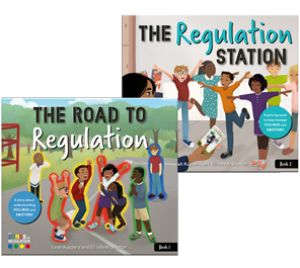The Road to Regulation & The Regulation Station

These two sequential, illustrated storybooks provide engaging social scenarios and strategies to help children at developmental ages 5-11 explore how lessons from The Zones of Regulation curriculum book can be used at school and at home. Kids love stories and will identify with the characters and the everyday situations as they learn about their feelings and emotions and how their bodies help show and tell them what they are feeling. Readers will also learn along with the characters that they can manage and control how they feel by using tools—such as movement, activities, and art—to relax, focus, and stay calm so they can meet their goals and needs of the day.
The Road to Regulation (storybook 1) takes readers on a school-day journey as Gabriel and his classmates learn about The Zones of Regulation throughout their day. Whether they are on the noisy bus, trying to focus in class, feeling left out in the cafeteria, or scoring a homerun in a kickball game, they experience a wide range of feelings in different sizes, intensities, and levels of energy. During a school assembly, they learn that all those high, low, and in-between feelings fit into four colored Zones. The Zones of Regulation gives them an easy way to talk and think about their feelings and the connection to what their bodies are feeling and doing. When a fire alarm sends everyone reeling in different ways, the kids have a perfect opportunity to reflect on the ups and downs of their day and see how they were in different Zones at different times. Best of all, they realize that all Zones—and all feelings—are okay and learning to recognize and understand them are the first steps on The Road to Regulation.
In The Regulation Station (storybook 2), Gabriel falls asleep and dreams that he’s on a fantastic adventure with his friends. After a wild bus ride, they discover a magical place, The Regulation Station, filled with activities, art, and movement. As they explore different experiences at the Regulation Station, they notice how they feel afterward–more relaxed, focused, and calm. Back at school, Gabriel realizes that the activities from his dream are called “tools”—and that these very real tools have special powers that help him and his classmates (and all of us!) regulate their feelings and bodies so they can meet the needs of their day in the classroom, on the playground, and with their families.
Is this your Product Page? Improve it! Login now to update your information.





